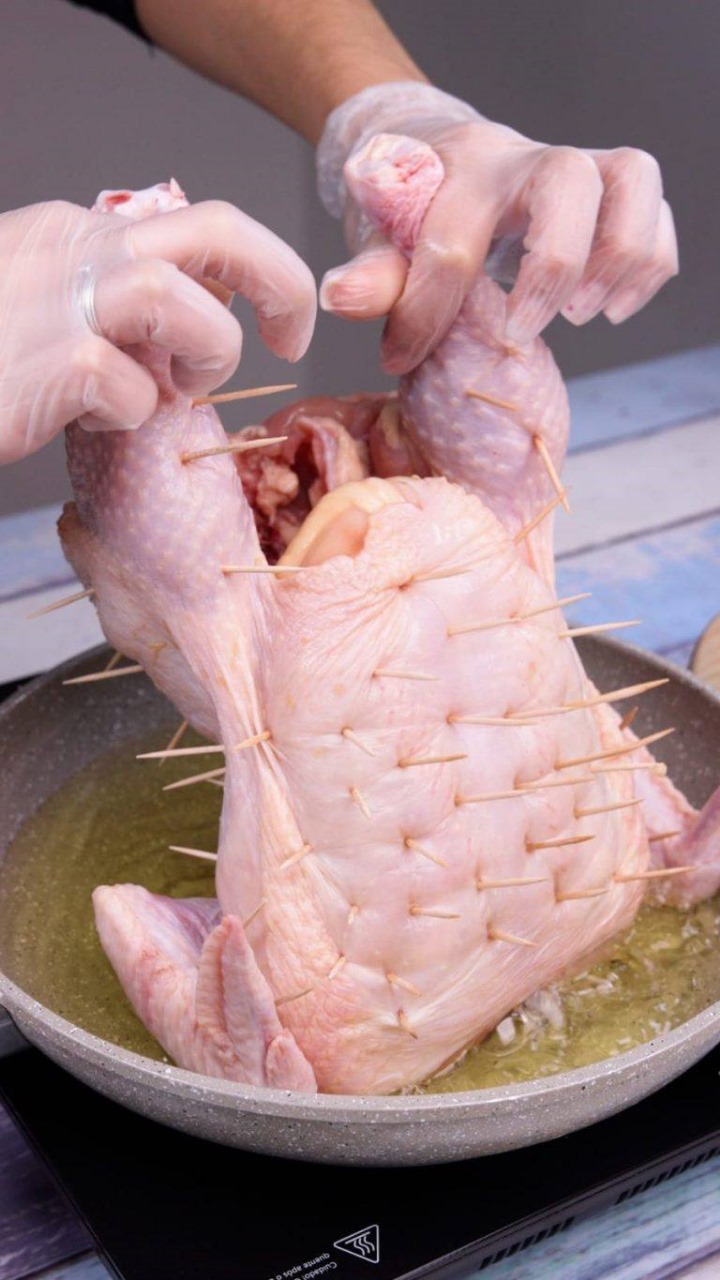ADVERTISEMENT
1. Prepare the Brine:
- In a medium pot, combine the water, kosher salt, and sugar. You can also add flavoring agents like crushed garlic, herbs, or a bay leaf to enhance the brine with aromatic flavors. Bring the mixture to a simmer, stirring occasionally to dissolve the salt and sugar. Once fully dissolved, remove from heat and let the brine cool to room temperature.
2. Submerge the Chicken:
Once the brine has cooled, place the chicken (whether it’s whole, breasts, thighs, or drumsticks) into the brine solution. Ensure the chicken is fully submerged—if needed, you can use a heavy plate or something to weigh it down.
If you’re short on time, you can use an ice bath (about 1 cup of ice for every cup of brine) to cool the brine quickly, allowing you to start the brining process sooner. However, make sure the brine is cool before adding the chicken to avoid cooking it prematurely.
- Let the Chicken Brine:
For Whole Chicken: Brine the whole chicken for at least 4-6 hours (or up to overnight).
For Chicken Breasts/Thighs: Brine smaller pieces of chicken for 30 minutes to 2 hours—this helps preserve the chicken’s tenderness and flavor without over-salting it.
- Rinse and Dry:
After the brining time is up, remove the chicken from the brine and rinse it thoroughly under cold water to remove excess salt.
Pat the chicken dry with paper towels—this step is essential for achieving crispy skin when cooking.
- Cook as Desired:
Once your chicken is brined, you can cook it in your preferred method—whether that’s roasting, grilling, pan-searing, or frying. The brined chicken will be juicier, more flavorful, and tender than you ever thought possible!
How to Cook Brined Chicken for the Best Results
Brining gives you a head start, but how you cook the chicken afterward is just as important. Here’s how to make sure you get crispy skin and perfectly cooked chicken every time.
For Roasting or Baking:
Preheat your oven to 400°F (200°C).
Place the brined chicken on a rack over a baking sheet to allow air circulation, which helps crisp the skin. You can brush the chicken lightly with olive oil or melted butter for extra flavor.
Roast for 35-45 minutes (depending on the size of the chicken pieces) or until the internal temperature reaches 165°F (74°C) in the thickest part of the meat. For a whole chicken, this may take longer, around 1 to 1.5 hours, depending on size.
Let the chicken rest for 10 minutes before serving to allow the juices to redistribute.
For Grilling:
Preheat your grill to medium-high heat.
Place the chicken pieces skin-side down on the grill and cook for 5-7 minutes per side (depending on the size of the pieces), ensuring the chicken reaches an internal temperature of 165°F (74°C).
Brush the chicken with your favorite marinade or barbecue sauce during the last few minutes of grilling for extra flavor.
For Pan-Seared Chicken:
Heat a tablespoon of oil in a skillet over medium-high heat.
Add the brined chicken (skin-side down if using skin-on pieces) and sear for 4-5 minutes per side, or until golden brown and crispy. You can lower the heat to finish cooking through if needed, ensuring the chicken reaches 165°F (74°C) internally.
Why Brined Chicken Tastes Better
Juiciness: Brining helps the chicken retain moisture, preventing it from drying out during cooking. This results in tender, juicy meat that stays moist even when cooked at high temperatures.
Even Seasoning: The salt from the brine penetrates the chicken, ensuring that each bite is perfectly seasoned, not just the surface.
Crispy Skin: By removing excess moisture and drying the skin before cooking, brined chicken develops a beautifully crispy skin when roasted or grilled, which adds texture and flavor.
Flavor Depth: The brine can infuse more than just salt into the chicken. With the addition of herbs, garlic, and spices, your chicken absorbs those flavors as well, making each bite complex and full of rich taste.
Restaurant-Quality: The key to high-end restaurant dishes is often in the preparation. This brining trick is a well-known secret among chefs because it guarantees the chicken will come out tender, juicy, and perfectly seasoned every time.
Tips for Perfectly Brined Chicken
Don’t Over-Brine: While brining helps retain moisture, it’s important not to overdo it. Brining for too long can result in overly salty chicken. Stick to the recommended times for the best results.
Use Fresh Ingredients: If you’re adding herbs, garlic, or spices to your brine, use fresh ingredients for the best flavor. Dried herbs can be used, but fresh ingredients will give the chicken an added aromatic depth.
Rest the Chicken Before Cooking: After brining and rinsing, always pat the chicken dry and let it rest for a few minutes before cooking. This will ensure that the skin crisps up beautifully when roasted or grilled.
Conclusion: The Best Chicken You’ll Ever Eat
Brining chicken might sound like a small step, but it makes all the difference in the world. This simple trick—learned from a famous restaurant—has transformed my chicken from basic to extraordinary. Juicy, flavorful, and perfectly seasoned, this is the chicken you’ll want to make again and again.
So the next time you’re preparing chicken for dinner, try this brining method. It’s the secret behind restaurant-quality poultry that you can easily recreate at home. Your family and guests won’t believe how tender, flavorful, and juicy your chicken turns out—and they’ll definitely want the recipe!
ADVERTISEMENT
